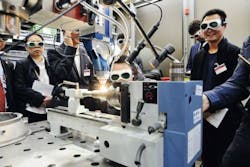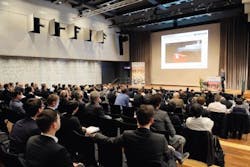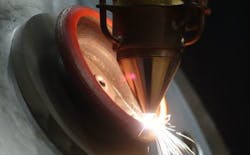Conference highlights emerging manufacturing technologies for turbine construction
The ICTM Conference, a biennial event organized by the International Center for Turbomachinery Manufacturing (ICTM; Aachen, Germany), has established itself as a networking hub for the international turbomachinery industry. Held in collaboration with the Fraunhofer Institutes for Production Technology (IPT) and Laser Technology (ILT), this year's conference took place February 15-16, 2017, where more than 250 experts from 19 countries discussed how to more efficiently develop and manufacture turbines for power plants and aircraft in the digital age.
Over the two-day event, 21 presentations dealt with the influence of advanced machining, additive manufacturing, and Industry 4.0 on turbomachinery production. Forty-four live demonstrations included additive manufacturing, ultrashort-pulse lasers, five-axis waterjet cutting, and cryogenic cooling of materials that are difficult to machine.
How innovation changes in times of disruptive, revolutionary technologies that supersede other processes was a topic examined by Dr. Ingomar Kelbassa, Department Manager for Manufacturing Development and Industrialization at Siemens AG (Power and Gas Division; Berlin, Germany). "Additive manufacturing in conjunction with the digitalization of production allows us to significantly bypass traditional processes," Kelbassa explains. "For that to happen, though, those involved have to change the way they think."
Recently, Siemens proved that using additive manufacturing as an alternative to standard approaches could pay off. The company had already introduced solutions for gas turbine combustion system components that were ready for production, but then it had a breakthrough in the 3D printing of rotating components. The company fully tested the turbine blades, which were produced from start to finish using additive manufacturing in a gas turbine. The process employed the selective laser melting (SLM) process developed at Fraunhofer ILT, which Kelbassa discussed.
The 18 presentations that followed were given by speakers from both industry and research, who examined further challenges facing today's turbomachinery manufacturing. Among other issues, they considered developments in the fields of laser metal deposition and SLM, processes for blisk production, and a newly developed method for analyzing big data in turbomachinery manufacturing.
A presentation given by Dr. Volker Kreidler, Head of Industry 4.0 Products & Innovations at SAP SE (Walldorf, Germany), highlighted a very important aspect of the digital transformation in turbomachinery manufacturing. The growing number of sensors and powerful evaluation electronics brings about ever-increasing amounts of data, known as "big data." For example, if a computer records 20 values (64 bits) per millisecond, it will save 4.3GB of data over the course of an eight-hour shift. Yet, how can we handle such a constantly growing volume of data? Which data can be processed in real time? How do users gather data from a wide range of sources? Every company must solve these and many other problems in the coming years if it wants to effectively use the advantages of digital transformation, Kreidler stressed.
As a result, big data is likely to be one of the main topics at the next ICTM Conference in February 2019.
For more information, please visit www.ictm-aachen.com.


